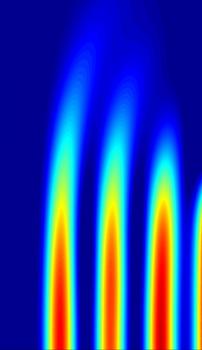Jun 26 2015
Yet it has the potential for numerous applications. In Physical Review Letters, scientists at Jülich together with their international partners present a new concept that uses short-pulse lasers to expand the capabilities of terahertz sources currently being developed. An important part was played by calculations performed on Jülich's supercomputer JUQUEEN.
 This image shows the propagation of the terahertz waves in ionized gas in a magnetic field of 178 tesla. Credit: Forschungszentrum Jülich
This image shows the propagation of the terahertz waves in ionized gas in a magnetic field of 178 tesla. Credit: Forschungszentrum Jülich
Using detailed simulations, the scientists showed how the wavelengths and polarization of the generated terahertz radiation can be controlled via a strong external magnetic field. In the electromagnetic spectrum, terahertz waves occupy a band between microwaves and infrared radiation. The range from 0.1 THz to 30 THz, the so-called "terahertz gap", sits right between electronics and optics and is therefore not accessible through conventional electric devices or optical sources such as antennas and lamps. However, its special properties make THz radiation interesting for a variety of reasons: on the one hand, it penetrates textiles and plastics, while on the other, it is absorbed by many materials in a characteristic manner. The application spectrum ranges from non-invasive early cancer screening to food controls and body scans as well as ultrafast wireless connections.
Since the beginning of this century, femtosecond laser-based sources generating terahertz waves have been in use as comparatively compact and cheap alternatives to large particle accelerators. "This method works like a transformer that converts the high frequency of the incoming laser beam into the lower terahertz frequency range," explains Prof. Paul Gibbon from the Jülich Supercomputing Centre (JSC).
One particularly favourable technique, which is currently being refined, utilizes two ultrashort laser pulses of different frequencies which are aimed at a gas target. The gas is ionized and electrons are released. In this way, the much faster laser oscillationsare transformed into terahertz waves with lower frequencies. "The strong electromagnetic fields of the two lasers cause the electrons to oscillate but not quite harmonically - or sinusoidally - but instead asymmetrically, which when averaged over the laser cycle produces a type of direct current," says Humboldt fellow Dr. Wei-Min Wang, who also works at the Jülich Supercomputing Centre (JSC). The frequencies would otherwise remain in the higher range of lasers. "In this way, a terahertz pulse is generated that lasts exactly one cycle - and then radiates outwards," says Wang.
Together with researchers at the University of Strathclyde and the Institute of Physics in Beijing, which is part of the Chinese Academy of Sciences, the two researchers have now published a paper on their new concept, which would enable the generation of terahertz radiation with tunable wavelengths over several cycles with a narrow bandwidth - characteristics that are similar to those of lasers in the optical range. It utilizes a strong magnetic field which is applied externally to the ionized gas and forces the free electrons in the plasma to gyrate like in a particle accelerator. This orbit determines the wavelength as well as the direction of oscillation of the resulting radiation. The optical properties can be tuned as required by altering the strength of the magnetic field - which could open the door to a wide variety of new applications.
"Spectroscopic and imaging techniques - like, for example, those used to investigate the dynamics of large biomolecules such as DNA - could particularly benefit from such a radiation source as it promises better temporal and spatial resolving power," explains Wei-Min Wang. However, practically implementing it is not that easy, and an experimental verification has yet to be realised. "The concept requires a combination of powerful lasers and magnetic fields exceeding 100 tesla. Technically, this is extremely challenging, but it is possible within the given space and time scales," says Paul Gibbon. The scientists are performing complex simulation calculations on one of the fastest supercomputers in Europe - Jülich's supercomputer JUQUEEN - to explore the properties of the new terahertz source.